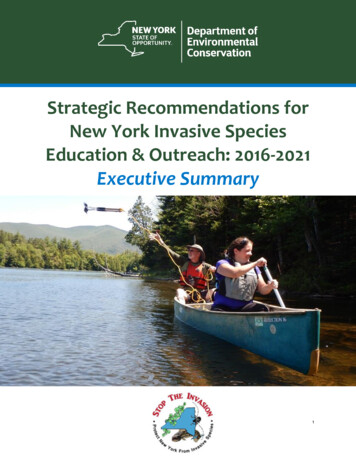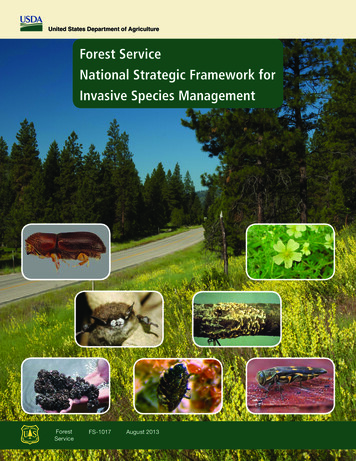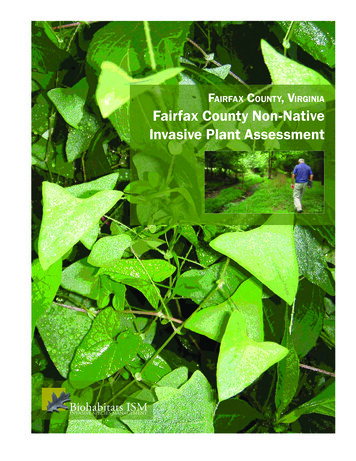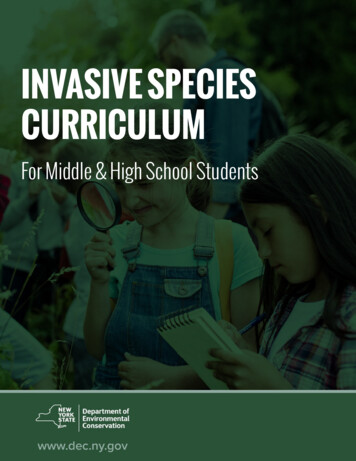
Transcription
Guidelines for invasivespecies planning andmanagement on islandsINTERNATIONAL UNIONFOR CONSERVATION OF NATUREWorld HeadquartersRue Mauverney 281196 Gland, SwitzerlandTel: 41 22 999 0000Fax: 41 22 999 0002www.iucn.orgGLOBAL SPECIES PROGRAMMECIASNETCaribbean Invasive Alien Species NetworkWIONIS
Guidelines for invasivespecies planning andmanagement on islands
The designation of geographical entities in this book, and the presentation of the material, do not imply the expression of any opinionwhatsoever on the part of IUCN, the European Commission, or other participating organisations concerning the legal status of anycountry, territory, or area, or of its authorities, or concerning the delimitation of its frontiers or boundaries.The views expressed in this publication do not necessarily reflect those of IUCN, the European Commission, or other participatingorganisations.This publication has been made possible in part by funding from the European Union under project DCI/ENV/2009/6/8 Preparation andtesting of a comprehensive model for preventing and managing the spread of invasive species on island ecosystems (the Inva’Ziles Project).Published by:IUCN Cambridge, UK and Gland, SwitzerlandCopyright: 2018 IUCN, International Union for Conservation of Nature and Natural ResourcesReproduction of this publication for educational or other non-commercial purposes is authorised withoutprior written permission from the copyright holder provided the source is fully acknowledged.Reproduction of this publication for resale or other commercial purposes is prohibited without prior writtenpermission of the copyright holder.Citation:IUCN (2018). Guidelines for invasive species planning and management on islands. Cambridge, UK andGland, Switzerland: IUCN. viii 40pp.Compiler and editor:Alan TyeISBN:978-2-8317-1919-1 (print version)978-2-8317-1918-4 :Cover and interior photographs: Chris Buddenhagen (p. 1 centre), Sue Daly/naturepl.com (cover bottom left), Gillian Key (p. 13 centreright), Christophe Lavergne (p. 13 centre left), and Alan Tye (other photos).All the photographs used in this publication remain the property of the original copyright holder.Photographs should not be reproduced or used in other contexts without written permission from thecopyright holder.Layout by:NatureBureau www.naturebureau.co.ukPrinted by:BSR Imprimeurs SA on 115 gsm mat paper, with cover on 240 gsm semi-mat paper, all papers made fromwood fibre from forests certified in accordance with the rules of the Forest Stewardship Council (FSC).Available from:IUCN (International Union for Conservation of Nature)Global Species ProgrammeRue Mauverney 281196 GlandSwitzerlandTel 41 22 999 0000Fax 41 22 999 0002www.iucn.org/resources/publicationsii
ContentsWhat are these Guidelines for?. ivWho are they for?. ivHow do I use these Guidelines?. vWhy produce these Guidelines?. viContributors. viKey terms, concepts, acronyms. viiForeword.viiiThe Guidelines Checklist.1A. Foundations.2A1: Planning and decision-making.2A2: Generating support.3A3: Building capacity.4A4: Legislation, policy and protocols.6B. Information and prioritisation.8B1: Baseline and monitoring change.8B2: Prioritisation.8B3: Research on priorities.9C. Management action. 10C1: Biosecurity. 10C2: Management of established invasives. 11C3: Post-management restoration. 12How to . 131. How to: engage, build momentum and support. 14Engaging all strands of society. 14Key awareness messages. 15Difficult customers. 16How to mainstream. 18‘Self-help’ – how to develop regional networks. 192. How to: write the plan, prioritise, make decisions . .23How to form and operate a National Invasive Species Committee.23How to write an Invasive Species Strategy and Action Plan (ISSAP).23How to prioritise.27Prioritising areas of action.27Prioritising species, pathways and sites for action.29How to select management goals for a species or site.31Making hard decisions: attitude, positive thinking.343. How to: translate the plan into action.35The ‘Project Cycle’ . .35After selecting your project.36Resources.38iii
What are these Guidelines for?The purpose of this document is to assist anyone planning and programming the management of invasivespecies on islands, with the aim of reducing the negative impacts of invasives on islands’ rich and fragile natural heritage,communities and livelihoods.These Guidelines aim to: Provide a comprehensive framework for invasive species management on islands Address all problem areas and facilitate prioritisation Increase action and improve implementation Increase efficiency and cooperation, reduce duplication Guide the work of international and regional agencies, including donors Guide the development of country and island programmes, including NationalInvasive Species Strategies and Action Plans and individual agency plans Guide strategic and local fundraising.These Guidelines deal with invasive plants, animals, disease agents and other organisms, in marine, freshwater andterrestrial environments, and their impacts on the environment, biodiversity, ecosystem services, human health, economiesand society. All of the main thematic areas and their objectives are required for comprehensive management of the invasivespecies threat. These Guidelines reflect and are compatible with relevant international conventions and standards (seeResources p. 38), and are intended to assist planners and practitioners to meet accepted standards and best practice.Who are they for?This document provides guidance for anyone planning an invasive species programme, on islands anywhere.It provides support for islands in developing their invasive species plans and programmes, as well as guidance forinternational and regional agencies in providing assistance to them (N.B. throughout this document ‘regional’ refers toocean regions e.g. Pacific, Caribbean ). The guidance is intended for any organisation working on invasives on islands,including international and regional agencies, national and local government departments (e.g. quarantine, biosecurity,forestry, agriculture, water management, conservation), NGOs, protected area and conservation managers, scientists, andanyone else who has to find, plan and prioritise funds and resources for invasive species management and research.For the purpose of these Guidelines, ‘islands’ are primarily islands of land in oceans, irrespective of size or isolation, butthe guidance should also be useful for planning invasive species programmes anywhere, including in continental areas.If you work for an internationalor regional organisation, usethese Guidelines to help you to: Identify your niche for invasive specieswork in the island region(s) where youoperate. Identify priority island needs thatrequire action by your agency. Identify other agencies with whom youcould or should coordinate your work.If you work for a national or localinstitution or programme, use theseGuidelines to help you to:iv Identify and prioritise objectives needing actionwithin your jurisdiction. Design your invasive species strategy, plan yourwork programme, and put it into action. Determine how to coordinate your work withother countries and organizations, and benefitfrom their experience and assistance. Justify your projects to decision-makers anddonors.
How do I use these Guidelines?Following this brief introduction (pp. iv–viii), the document comprises two main sections.The first of these is a Checklist (pp. 1–12) of the essential components of a comprehensive and effective invasivespecies management programme, arranged in a logical order of ten Thematic Areas, grouped into three overall Themes(Foundations; Information and Prioritisation; Management Action). All 10 Thematic Areas need to be considered whenplanning an invasive species programme for an island or islands.The second section, ‘How to’ (pp. 13–37), provides supplementary guidance on the planning and implementationprocess, mainly on how to engage, build momentum and support, make decisions, prioritise, and translate plans intoaction. These Guidelines may be used as an aid in planning and designing any invasive species programme, at alocal, national or regional level. They help to ensure that key aspects relevant to any given situation or programmeare not forgotten.These Guidelines are comprehensive and therefore contain many objectives, but not every country or agency needsto do everything. Not all of the objectives will be necessary for your agency or programme. Some are appropriatefor implementation at a national or local level, while others require international cooperation or are more suitable forimplementation by regional or international agencies. Each agency can select the objectives that it considersimportant for its own programme.The objectives are not prioritised, because priorities and needs differ in different islands, countries and territories. TheGuidelines facilitate prioritisation by your country, territory, island or agency; they do not set priorities for you.Don’t be dismayed – start small!This document might look complicated, but don’t worry – if you are working on a simple plan for very limitedresources it can still help you. See the ‘How to’ sections for common-sense advice (especially pp. 23–26), and use theChecklist to give you ideas. These Guidelines are written to help you, not to waste your time. You may feel that you have nochance to implement even just a few actions, and wonder where to start. Just focus on the following actions that islandswith limited capacity can take as top priorities: Identify the key institutions and experts available on island, or people who can offer help from elsewhere. Workwith them.Identify the few most important introduction pathways (e.g. garden plants, untreated wood, rat-infested freightersetc.) and work on improving biosecurity controls.Identify easy wins – projects where you can really achieve complete eradication or bring an invasive under effectivecontrol.Focus long-term management on protecting the last patches of relatively undisturbed habitat or highly threatenednative species. Choose one or two projects where you can expect success.Using the ChecklistWhen planning, you can use the Checklist section as a starting point and for structuring planning discussions inworkshops. The Checklist outlines Actions that you may wish to include in your plan. Different islands and agencies,planning for different kinds of programme, will want to select different actions as their priorities. Also, different individualcontributors to your plan may have very different ideas about what should be included in it. The Checklist should help youto select actions more objectively, balancing the suggestions made by different people and agencies. You can use the tick boxes on the left of each Action to indicate that you have considered and either accepted ( ) or discarded ( ) it,and then refer back to the Checklist once you have your draft plan, to make sure that it includes the Actions.Using the ‘How to’ sectionsYou can use the decision-making tools and guidance in the ‘How to’ sections, to help you resolve differences of opinionand choose actions that will make a difference and which you can achieve within the limits of available (or realisticallyobtainable) resources.Planning from experienceThe planning process may go more smoothly if you bring in a lead facilitator experienced in this kind of planning. This ishighly recommended for planning at any level, but particularly for plans serving diverse user groups, such as National (orindividual island) Invasive Species Strategies and Action Plans (ISSAPs). For further guidance on how to plan, see the ‘Howto’ sections on pp. 23–37.v
Why produce these Guidelines?The rate of movement of plants, animals and other organisms beyond their natural range is rising sharply, due to increasedtransport, trade and travel. Many species that are introduced to new places by people do not cause problems in their newlocations, and many bring considerable benefits to people, including in agriculture, horticulture and forestry. However,‘invasive species’ (often called pests, weeds and diseases) are plants, animals, disease agents and other organisms takenbeyond their natural range by people, deliberately or unintentionally, and which become destructive to the environmentor human livelihoods. They threaten biodiversity, natural resources, food security, economic development, human health,and ecosystem services such as water resources, nutrient cycles and erosion. Environmental changes caused by humanactivities can sometimes result in a native species similarly proliferating and becoming destructive. These ‘native invasivespecies’ must also sometimes be managed.Islands are particularly vulnerable to invasive species. Islands and their surrounding near-shore marine areas oftenconstitute unique ecosystems, with many plant and animal species that are endemic (found only there), and which have notevolved to cope with the predators, herbivores, insect pests, highly competitive weeds, and diseases found on continents.As a result, species introduced to islands are the main cause of extinction of island native species. Islands are alsosusceptible to invasion because their economies rely heavily on imported goods and on travel (tourism): this generates highrates of arrival of new species, and requires strong partnerships to balance biosecurity with sustainable livelihoods.Island ecosystems are key to the welfare and culture of 600 million islanders, one-tenth of the world’s population. Invasivespecies on islands affect agriculture, aquaculture, fisheries, forestry and tourism; they reduce land values, damagebuildings, obstruct waterways, disrupt trade and transportation, and cause or transmit diseases of humans, domesticanimals and crops. Management of invasive species benefits island environments, food security, incomes, health andsociety, but small island states often have limited human, material and financial resources for tackling such threats.Invasive species are an international problem, so their effective management on islands requires coordinated action byinternational and government agencies, NGOs, the private sector and local communities. Good resources exist to helpplanners and managers with many aspects of invasives management, including species control techniques, biosecurity,project design, legislation, raising awareness and many others. Some examples are listed in Resources (pp. 38–40).In 2009, the Pacific Regional Environment Programme produced the Guidelines for Invasive Species Management inthe Pacific (SPREP, 2009), a guidance document to assist Pacific islands to plan and manage their invasive speciesprogrammes, which was immediately and enthusiastically adopted throughout Oceania. In 2016, a regional consultationin the Western Indian Ocean identified planning guidance as a gap in available resources there, and a subsequent globalconsultation via invasives e-mail lists supported this, and showed broad agreement that the Pacific Guidelines could serveas a basis for an adapted and updated document for invasives planners on islands worldwide. Further consultations on adraft based on the Pacific Guidelines were held at the 2016 World Conservation Congress and the 2017 Island Invasivesconference, and subsequently by e-mail lists. The present document is the result, and is designed to be compatible withrelevant international and regional conventions, standards and indicators, to facilitate and coordinate their application, andto assist programmes and projects to meet accepted international standards and best practice. In particular, it is designedto support compliance with the Convention on Biological Diversity (Rio Convention; Article 8h: ‘Prevent the introductionof, control or eradicate those alien species which threaten ecosystems, habitats or species’), the Aichi targets (especiallyTarget 9: “invasive alien species and pathways are identified and prioritized, priority species are controlled or eradicatedand measures are in place to manage pathways to prevent their introduction and establishment”) and SustainableDevelopment Goals, National Biodiversity Strategies and Action Plans (NBSAPs) and National Invasive Species Strategiesand Action Plans (see Resources p. 38).ContributorsThese Guidelines could not have been written without the voluntary contributions of many experts in invasives planning andmanagement, and potential users on islands worldwide, who told us what kind of guidance they needed. All contributors arelisted below. The Pacific Guidelines were also produced with contributions from many people, some of them the same asthose who reviewed drafts of the present one. Without all of this valuable input over many years, this document would havebeen incomplete and unable to claim to represent islands worldwide. We hope that this broad range of contributions will fosterownership of the document by all islands, NGOs and other agencies seeking to manage invasive species throughout the world.The Director-General of SPREP, Kosi Latu, kindly gave permission to adapt and use material from SPREP’s Guidelines forInvasive Species Management in the Pacific. The present document was compiled and edited by Alan Tye, who also wrotemuch of the text and incorporated the contributions of 103 people (listed below) from islands and institutions worldwide.Substantial sections were written by Souad Boudjelas (Pacific), Alison Copeland (Bermuda), Geoffrey Howard (IUCN),Jill Key (Pacific, and UK Overseas Territories), Ulrike Krauss (St Lucia) and Olivier Tyack (IUCN). Piero Genovesi and JillKey reviewed a full draft. Additional contributions, suggestions, review and encouragement were provided by AdemolaAjagbe, Katy Beaver, Alex Bond, Elsa Bonnard, Olaf Booy, Rafael Borroto, Nancy Bunbury, Earl Campbell, Dario Capizzi,Juli Caujapé-Castells, Ana Costa, Franck Courchamp, Phil Cowan, Steve Cranwell, Cathleen Cybèle, Curt Daehler, Maríavi
Cristina Duarte, Julia Dunn, Rui Bento Elias, Marco Filipovic, Julian Fitter, Frauke Fleischer-Dogley, Jason Goldberg, InesGómez, Viliami Hakaumotu, Sjúrður Hammer, Chad Hanson, Olivier Hasinger, Lynley Hayes, Ben Hoffmann, Nick Holmes,Stephanie Hudin, Jason Jack, Patricia Jaramillo, Marie-May Jeremie-Muzungaile, Gabe Johnson, Chris Kaiser-Bunbury,Springer Kaye, Inti Keith, John Kelly, Michael Kiehn, Cynthia Kolar, Christoph Kueffer, Marta López Darias, Janice Lord,Ian MacDonald, Gwen Maggs, Christy Martin, Kelly Martinou, John Mauremootoo, Mathilde Meheut, Tommy Melo, JeanYves Meyer, Joel Miles, Aileen Mill, James Millett, Nitya Mohanty, Craig Morley, David Moverley, Bradley Myer, RachelNeville, Ray Nias, Kimberley O’Connor, Warea Orapa, Shyama Pagad, Julián Pérez, John Pinel, Bruce Potter, ParmenandaRagen, Frida Razafinaivo, Tim Riding, Gérard Rocamora, James Russell, Susana Saavedra, Adrian Schiavini, RichardSelman, Nirmal Shah, Greg Sherley, Andy Sheppard, Junko Shimura, Didier Slachmuylders, Kevin Smith, Antonio Soares,Yohann Soubeyran, Vikash Tatayah, Sophie Thomas, Anna Traveset, Magdalena Vicens, Jeanne Wagner, Josua Wainiqolo,Katherine Walls, Andrew Walsh, Marc Woodhall, Masahito Yoshida, Glyn Young and Kristi Young. Consultative meetingswere organised by Olivier Hasinger, David Moverley, Ray Nias, Kevin Smith and Alan Tye. Design and layout by BarbaraCreed of naturebureau.co.uk, Kevin Smith and Alan Tye.Key terms, concepts, acronymsMost terms, concepts and acronyms used in this document are defined at first mention in the text. The following occurfrequently and are listed here for ease of reference. Some of the terms below are defined in a restricted sense for thepurpose of this document, in the specific context of islands. See https://www.cbd.int/invasive/terms.shtml for aglossary of invasive species terminology.biocontrol orbiological controlControlling an invasive species by introducing a natural enemy, such as an insect orfungus, that specifically attacks the target species and does not attack native oreconomically important species.biosecurityPreventing the spread of invasive species across international or internal borders, includingbetween islands (often termed “prevention”)containmentKeeping an invasive species within a defined area.controlReducing the population of an invasive species.effective managementAchieving operational success (e.g. reducing the pest to defined levels) and desiredoutcomes (reduced impact, recovery of impacted values) of invasive species management.eradicationComplete elimination of an invasive species from an island (or other isolated area).introduced speciesPlant, animal or other organism taken beyond its natural range by people, deliberately orunintentionally. Also termed “alien” or “non-native” species.invasive speciesAn introduced species that becomes destructive to the environment or human interests.monitoringProgrammes to detect change, e.g. in the distribution of invasive species, the success ofmanagement projects etc.native invasive speciesA native species that proliferates and becomes destructive following environmentalchanges caused by human activities.native speciesA species that occurs naturally on an island or in a specified area, having either evolvedthere or arrived there without human intervention.pathwayThe process or mechanism by which a species is moved from its native area into a new area.region, regionalThe islands in a particular ocean or part of an ocean.surveillanceMonitoring to detect new incursions of invasive e Species Strategy and Action PlanNational Biodiversity Strategy and Action PlanNon-governmental organisationNational Invasive Species CommitteePacific Invasives Learning NetworkPacific Invasives PartnershipSecretariat of the Pacific Regional Environment ProgrammeWestern Indian Ocean Network on Invasive Speciesvii
Forewordfrom the President of the Republic of PalauForewordHere in the Pacific, we like to think that we are world leaders in our commitment to theeffective management of Invasive Species, and are proud of our well-documentedapproach to this commitment. Since 2009, our small island nations have enjoyed the useof a guidance document produced for us by the Pacific Regional EnvironmentProgramme (SPREP) known as 'Guidelines for Invasive Species Management in thePacific', which has been adopted by all the island countries and territories of Oceania. Itis therefore a special pleasure, and indeed an honor for the Pacific, to see that theInternational Union for Conservation of Nature (IUCN) has taken this guidance to therest of the world by modeling their guidelines document on our original Pacific one, withthe gracious permission of SPREP, while updating and expanding it with additionalmeasures.Our island governments have used the Pacific Guidelines as the basis for many of ournational and territorial Invasive Species plans, which have, as a result, become morerealistic, more objective, and more focused on the key problems that we can tackle withour limited resources. The Guidelines have also greatly helped to raise the profile ofInvasive Species on our national agendas, and on the agendas of the international andregional agencies that assist us.Given the enormity of the threat to islands posed by Invasive Species, it is very satisfyingto see IUCN take these improvements to islands worldwide. We all suffer the sameproblems that Invasive Species bring to sustaining our livelihoods and our environments,and the solutions to these problems are similar across the planet. These new globalGuidelines will assist all of us by improving our planning and management of this mostsevere threat to island biodiversity worldwide, and one of the greatest threats to islandeconomies and communities.I am very privileged to endorse this publication, which is full of practical advice andcommon sense, and I encourage its use by all concerned. It is a welcome addition to theset of tools available to island Invasive Species planners and managers and should resultin more effective action against Invasive Species on the part of islands, island nations,and international donors. I congratulate IUCN on its foresight and concern for our islandhomes.Tommy E. Remengesau, Jr.President of the Republic of Pala
v How do I use these Guidelines? Following this brief introduction (pp. iv-viii), the document comprises two main sections. The first of these is a Checklist (pp. 1-12) of the essential components of a comprehensive and effective invasive species management programme, arranged in a logical order of ten Thematic Areas, grouped into three overall Themes










